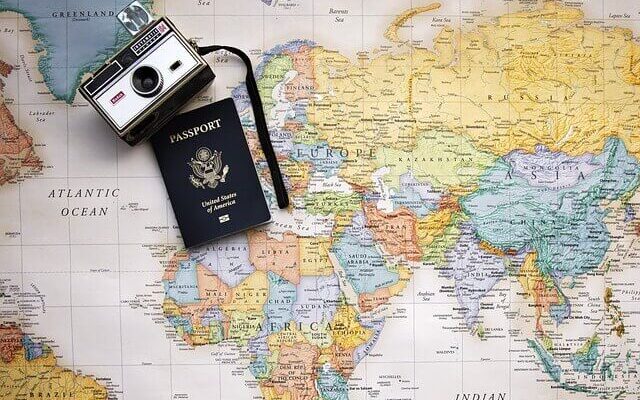What is Slow Traveling?
It’s about taking the time to make a connection—to the places that you visit, the land, and to each other.
Slow traveling is about not rushing from place to place but instead taking your time exploring and appreciating the moment. It is about getting involved in and experiencing the local culture, traditions, and daily life of the places you visit. In this blog post, we dive into the concept and beauty of slow traveling and its mindset, hopefully inspiring you to engage in a slow travel journey or implement parts of a slow traveling mindset on your next journey.
Slow Traveling: A Mindset

When slow traveling, it is not just about getting from A to B but also about valuing and enjoying the journey itself. Slow traveling is mindful and involves seeking a deeper experience and connection with the places you visit. When embarking on a slow travel journey, check-lists of tourist attractions and activities are avoided, and instead, spontaneity and serendipitous encounters are embraced.
While slow traveling encourages travelers to spend an extended period in a single location or geographic area, providing more time to immerse in the local culture, heritage, and way of life, slow travel is not solely about the length of your stay. Slow traveling is a mindset. It is about being fully present and immersing yourself in the world of the destination as you journey through it, whether you have just one day or three weeks to do so.
How to start traveling slower

Engaging in slow travel means incorporating some key elements of the mindset into your journey. It may start with changing your thoughts and expectations about traveling, the tempo of the journey, and the number of activities. Here are a few steps to inspire and spark your slow traveling journey:
- Abandon the must-see and to-do lists: As previously emphasized, focus on quality over quantity. It can be exhausting to cover too many points of interest and must-visits to be fulfilled in a single trip.
- Enjoy and appreciate the small things and moments. Pay attention to details and enjoy the moment. Try starting the days out with meditation or journaling.
- Learn from the locals: Opt for a travel approach that aligns with locals’ ways of doing things. For example, embrace local ways of eating and spending time together. Use their preferred transportation methods, such as train travel or cycling, and venture beyond the metropolitan epicenters.
- Use transportation methods like trains or buses when feasible. Take the time to enjoy the journey itself. Moving more slowly allows our minds to better absorb and appreciate our experiences. When on a plane, we often lift out of one place and drop into the next, sometimes without much awareness of the in-betweenness.
- Integration into Daily Life: Having a slow travel mindset goes beyond traveling adventures. It’s a mindset that can be used in and inspire your everyday life. Some may think it is just words – but it’s about altering your perception of travel and how you move through time and space. Learn to enjoy and value the journey, whether it’s your daily commute or any trip from A to B. Maybe go a different route than usual; do it without music to listen to the sounds of the route and place. Avoid rushing to get somewhere and aim to enjoy the journey and the small details it brings.
Benefits of Slow Traveling

- Recharging: Slow travel is a great way to avoid feeling tired and overwhelmed when you travel faster and with a to-do list to follow. Slow traveling allows your travel experience to be more relaxed and balanced.
- Environmental and Personal Connection: Slow travel allows for a deeper connection with your surroundings, including nature, yourself, and other travelers.
- Empowering Local Communities: An important part of slow traveling is getting involved in the local culture and supporting local businesses over big global brands. By doing this, you help the local community and the local economy. Supporting and engaging with local people and businesses also lets you learn more about the customs and traditions of the place you visit.
- Saving Money: You can save money by avoiding tourist traps and attractions and living more like a local. Staying in the homes of local people, renting apartments in less touristy parts, and cooking your own meals with local ingredients from grocery stores allow you to spend less while exploring and taking in a destination.
Slow travel Ideas and activities

No matter how and where you travel, there will be ways and activities inspired by slow traveling that can support a deeper connection with the places you visit. Traveling slower and applying a slow travel mindset also supports and aligns with a more sustainable and responsible way of traveling and supporting local communities.
Here is a list of slow-traveling activities to get you started:
- Visit local food markets, eateries, and street food stalls to try authentic dishes and flavors of the region.
- Nature walks and hikes through natural landscapes, parks, and trails, allowing you to connect with the environment.
- Participate in workshops such as cooking classes, pottery making, or traditional craft lessons to learn about local traditions and craftsmanship.
- Reading books about the destination and writing your journal.
- Meditate to set intentions, practice consciousness, and self-reflection, allowing a deeper connection with the place.
- Capture the essence of your surroundings through photography, taking the time to frame and compose your shots thoughtfully.
- Plan your trip around local festivals, music performances, or cultural events to immerse yourself in the local culture.
- Talk with locals to learn about their daily lives, traditions, and perspectives. Consider choosing accommodations like homestays, guesthouses, or agritourism experiences to connect with local hosts.
- Explore lesser-known or offbeat places within your chosen destination and avoid crowds. Explore beyond metropolitan epicenters.

Slow living and slow travel mean tamping down our built-in, conditioned obsessions with time and allowing ourselves and the world to move a little slower so that we can notice it better. Practice being present in the moment, appreciate local cultures, and avoid rushing from one attraction to another.
Thank you for reading!
Remember, being a responsible traveler involves choosing responsible operators, supporting local communities, and minimizing your environmental impact wherever you travel. Always research and prioritize destinations that prioritize conservation.
Don’t forget to check out our blog for more content on sustainability, travel, and more! Click here to visit now.
